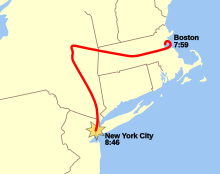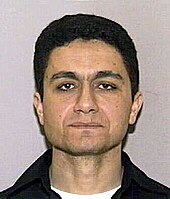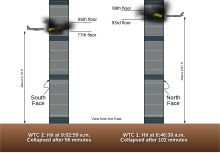American Airlines Flight 11
 AAL11 flight path from Boston to New York City | |
| Hijacking | |
|---|---|
| Date | 8:46 AM (EDT), September 11, 2001 |
| Summary | Terrorist hijacking |
| Site | World Trade Center |
| Aircraft | |
| Aircraft type | Boeing 767-223ER |
| Operator | American Airlines |
| Registration | N334AA |
| Flight origin | Logan International Airport |
| Destination | Los Angeles International Airport |
| Passengers | 76 (plus 5 hijackers) |
| Crew | 11 |
| Fatalities | 87 (plus 5 hijackers), and approximately 1,600 (including emergency workers) at the North Tower of the World Trade Center. |
| Survivors | 0 |
American Airlines Flight 11 was the first hijacked airplane of the September 11 attacks. It crashed into the North Tower of the World Trade Center. The American Airlines airplane was a Boeing 767. It was scheduled to fly from Logan International Airport in Boston to Los Angeles International Airport. Fifteen minutes after takeoff, the hijackers forced their way into the cockpit. One of the hijackers was a trained pilot. He took the controls of the aircraft and flew it into the North Tower. The hijackers were members of the terrorist group Al-Qaeda.
All 92 people on the airplane died in the crash—11 crew members and 81 passengers; 5 of them were hijackers. The crash took place at 08:46 Eastern Daylight Time. Many people near by panicked as they saw the crash. A few people were able to capture the moment of impact; Jules Naudet, a French cameraman who was filming a movie, and Pavel Hlava, a Czech immigrant. Additionally, a webcam set up by Wolfgang Staehle at an art exhibit in Brooklyn that took pictures of Lower Manhattan every four seconds, and a newscamera that was left on the ground also captured the crash. The crash and the fire that started right after it made the North Tower collapse within 102 minutes. The attack killed nearly 3,000 people and injured thousands more. It left a profound mark on American history and changed the system of airport security.
Flight
[change | change source]
The aircraft flying American Airlines Flight 11 was a Boeing 767-200ER. Even though it could carry a maximum of 158 passengers, the September 11 flight carried only 81 passengers and 11 crew members.[1] Flying the aircraft was pilot John Ogonowski and first officer Thomas McGuinness. The flight attendants were Barbara Arestegui, Jeffrey Collman, Sara Low, Karen Martin, Kathleen Nicosia, Betty Ong, Jean Roger, Dianne Snyder and Madeline Sweeney.[2]
Boarding
[change | change source]
Mohamed Atta, a member of terrorist group al-Qaeda in Afghanistan and the leader of the terrorists and another hijacker, Abdulaziz al-Omari, flew together from Portland, Maine to Boston, Massachusetts early on September 11, 2001. Both hijackers had first class tickets for a flight to Los Angeles, California.[1] Three other hijackers, Waleed al-Shehri, Wail al-Shehri and Satam al-Suqami arrived at Logan International Airport by car. All five checked in and by 07:40, were aboard the aircraft which was supposed to leave at 07:45.[3][4]
Mohamed Atta, the Egyptian leader of the terrorist attackers, sat in business class with Abdulaziz al-Omari and Suqami. Waleed al-Shehri and Wail al-Shehri sat in first class.[5] The aircraft taxied away from Gate B32 and departed Logan International Airport at 07:59 from runway 4R after a 14-minute delay.[6][7]
The hijacking
[change | change source]
It is thought that the hijacking of the plane started at 08:14. This was when the pilot and first officer stopped talking with air traffic control at Boston.[4] Two minutes later, the aircraft stopped flying along the route it was supposed to. No more radio replies came from the aircraft and the system in the aircraft used to avoid crashing into other aircraft was also switched off.[7] Flight attendants Ong and Sweeney, two of the several flight attendants, contacted American Airlines with AT&T airphones during the hijack. They said the hijackers had hurt two of the other attendants and killed an Israeli passenger.[8][9][10] During the four-minute call, Ong told the airline which seats the hijackers were sitting in and said no one could get into the cockpit, where the hijackers were now.[11]
At 08:23:38, Mohamed Atta tried to talk to the passengers from the cockpit but he pressed the wrong message button and sent the message to air traffic control.[12] He said that "[They] have some planes, just stay quiet and you'll be okay. We are returning to the airport." A minute later he said, "Nobody move. Everything will be okay. If you try to make any moves, you'll endanger yourself and the airplane. Just stay quiet."[7] Air traffic control finally realized that the aircraft had been hijacked, and they called the Federal Aviation Administration. Soon after, Atta announced, "Nobody move please, we are going back to the airport, don't try to make any stupid moves." Five minutes later, Boston air traffic control called North American Aerospace Defense Command (NORAD). NORAD ordered two F-15 fighter aircraft to catch the flight,[4] but it was too late—American Airlines Flight 11 had already made its last turn towards Manhattan and crashed into the North Tower of the World Trade Center no more than six minutes after the fighter aircraft had taken off.[7]
Crash
[change | change source]
At 08:46:40, Atta and the hijackers crashed Flight 11 into the northern side of the North Tower (Tower 1) of the World Trade Center.[7] The aircraft, traveling at about 466 miles per hour (750 km/h) [or 404 knots] and carrying about 10,000 U.S. gallons of flammable fuel, hit between the 93rd and 99th floors of the North Tower.[13] In all, 92 people on board were killed.[14]
Because of the angle the airplane struck, people could not escape from at or above where the aircraft had crashed (floors 100 and up). All stairs and elevators from the 92nd floor to at least the 99th floor were blocked by fire or debris, trapping 1,344 people.[15] Hundreds were killed right away by the impact. The rest either were trapped and died from the fire, smoke or the collapse of the tower, and some even died after they jumped or fell out the windows of the burning building.[16] More than one elevator shaft carried the burning fuel downward, exploding on the 44th floor sky lobby and the Lobby of the North Tower causing damage to the marble walls, shattering windows and causing severe burns to several people.[17]
Jules Naudet, a French cameraman filmed the crash.[18][19] A webcam set up at an art exhibition in Brooklyn to take pictures of Lower Manhattan, every four seconds, also filmed Flight 11 crashing into the North Tower.[20]
News organizations first reported an explosion at the World Trade Center. CNN interrupted a commercial at 08:49 with the headline that read "World Trade Center Disaster." President George W. Bush was arriving at an elementary school in Sarasota, Florida when he was told about the crash. The president said, "This is pilot error. It's unbelievable that somebody would do this. The guy must have had a heart attack."[21] The first news reports believed that the crash had been an accident until Flight 175 crashed into the South Tower at 09:03, minutes after.[22]
After the crash
[change | change source]
102 minutes after the crash, the North Tower burned and collapsed in on itself. Although the crash caused much damage, the fire caused by jet fuel was blamed for the damage and collapse of the tower.[23][24][25] Hundreds of rescue workers also died when the tower collapsed.[26]
Rescue workers at the site started to find remains of bodies from the victims of Flight 11 soon after the attack. Some workers found bodies strapped to airplane seats. Reports that the body of a flight attendant with her hands tied up was released in the days after the attacks, meaning that the hijackers may have used handcuffs. However, little evidence has been provided after the events to confirm whether this is in fact true or not.[27][28] Within a year, remains of the 33 victims that had been on Flight 11 had been identified.[29] They identified two other Flight 11 victims, lead flight attendant Karen Martin and another person, after body remains were discovered near Ground Zero in 2006.[30][31] In April 2007, examiners using newer DNA technology identified another Flight 11 victim.[32] The remains of two hijackers, who could have been from Flight 11, were also identified and removed from Memorial Park in Manhattan.[33] The remains of the other hijackers have not been identified and are buried with other unidentified remains at Memorial Park.[34]
In a video recording found months later in Afghanistan, al-Qaeda's leader, Osama bin Laden, seemed to say he planned the attack. He said he believed part of towers would collapse.[35] The flight recorders, or tapes that record useful flight data, for Flight 11 and Flight 175 were never found.[36]
After the attacks, the flight number for flights on the same route at the same takeoff time was changed to American Airlines Flight 25, and a Boeing 757 was used instead of a Boeing 767. An American flag was flown on the jet bridge from which Flight 11 departed from Logan Airport.[37]
Related pages
[change | change source]References
[change | change source]- ↑ 1.0 1.1 "Staff Report - "We Have Some Planes": The Four Flights — a Chronology" (PDF). National Commission on Terrorist Attacks Upon the United States. Archived from the original (PDF) on 2008-03-06. Retrieved 2008-05-25.
- ↑ "American Airlines Flight 11". CNN. 2001. Retrieved 2008-05-22.
- ↑ "9/11 Investigation (PENTTBOM)". Federal Bureau of Investigation. United States Department of Justice. September 2001. Retrieved 2008-05-22.
- ↑ 4.0 4.1 4.2 "'We Have Some Planes'". National Commission on Terrorist Attacks Upon the United States. July 2004. Retrieved 2008-05-25.
- ↑ "Investigating 9-11 -- The doomed flights". San Francisco Chronicle. 23 July 2004. Archived from the original on 2005-07-12. Retrieved 2008-05-22.
- ↑ Johnson, Glen (23 Nov 2001). "Probe reconstructs horror, calculated attacks on planes". Boston Globe.
- ↑ 7.0 7.1 7.2 7.3 7.4 "Flight Path Study - American Airlines Flight 11" (PDF). National Transportation Safety Board. 19 Feb 2002. Retrieved 2008-05-25.
- ↑ "Excerpt: A travel day like any other — until some passengers left their seats". The Seattle Times. 23 July 2004. Retrieved 2008-05-23.
- ↑ "Inside the failed Air Force scramble to prevent the Sept. 11 attacks". MSNBC. 28 June 2004. Archived from the original on 2009-09-18. Retrieved 2008-05-23.
- ↑ Woolley, Scott (23 April 2007). "Video Prophet". Forbes. Archived from the original on 2008-12-16. Retrieved 2008-05-23.
- ↑ Sullivan, Laura (28 January 2004). "9/11 victim calmly describes hijack on haunting tape". The Baltimore Sun. Archived from the original on 2011-06-04. Retrieved 2008-05-22.
- ↑ United States District Court for the Eastern District of Virginia (7 March 2006). "USA v. Zacarias Moussaoui - Trial Testimony by David Raskin". United States Department of Justice. Retrieved 2008-05-22.
- ↑ "NIST NCSTAR1-5: Reconstruction of the Fires in the World Trade Center Towers" (PDF). National Institute of Standards and Technology. October 2005. Retrieved 2008-05-25.
- ↑ Lagos, Marisa; Walsh, Diana (11 Sep 2006). "S.F. firefighters, others honor peers who died on 9/11". San Francisco Chronicle. Retrieved 2008-05-23.
- ↑ Dwyer, Jim; Lipton, Eric; et al. (26 May 2002). "102 Minutes: Last Words at the Trade Center; Fighting to Live as the Towers Die". The New York Times. Retrieved 2008-05-23.
- ↑ "Heroism and Horror". National Commission on Terrorist Attacks upon the United States. 2004. Retrieved 2007-08-18.
- ↑ Producers: Colette Beaudry and Michael Cascio. "Zero Hour". Inside 9/11. National Geographic Channel.
- ↑ Carter, Bill (6 February 2002). "CBS to Broadcast Videotape Shot Inside Towers During Trade Center Attack". Retrieved 2008-05-23.
- ↑ Glanz, James (7 Sep 2003). "A Rare View of 9/11, Overlooked". The New York Times. Retrieved 2008-05-23.
- ↑ Staehle, Wolfgang. "Rare Scenes from 9/11". Vanity Fair. Archived from the original on 2013-12-15. Retrieved 2007-06-12.
- ↑ Woodward, Bob; Balz, Dan (27 January 2002). "America's Chaotic Road to War". The Washington Post. Archived from the original on 2012-05-29. Retrieved 2008-05-26.
- ↑ Glaberson, William (13 Sep 2001). "After the Attacks: United Flight 175; Second Plane to Strike World Trade Center Tower Took a Deliberate Path". The New York Times. Retrieved 2008-05-23.
- ↑ National Construction Safety Team (September 2005). "Executive Summary". Final Report on the Collapse of the World Trade Center Towers (PDF). United States Department of Commerce.
{{cite book}}:|work=ignored (help) - ↑ Miller, Bill (1 May 2001). "Report Assesses Trade Center's Collapse". The Washington Post. Archived from the original on 2012-05-24. Retrieved 2008-06-12.
- ↑ Williams, Timothy (5 April 2005). "Report on Trade Center Collapses Emphasizes Damage to Fireproofing". The New York Times. Retrieved 2008-06-12.
- ↑ "Police back on day-to-day beat after 9/11 nightmare". CNN. 21 July 2002. Archived from the original on 2018-12-25. Retrieved 2008-05-23.
- ↑ Sachs, Susan (15 September 2001). "After the Attacks: The Trade Center; Heart-Rending Discoveries as Digging Continues in Lower Manhattan". The New York Times. Retrieved 2008-05-24.
- ↑ Gardiner, Sean; Rayman, Graham (15 Sep 2001). "Hijackers May Have Used Handcuffs". AM New York. Archived from the original on 2007-03-27. Retrieved 2008-05-24.
- ↑ O'Shaughnessy, Patrice (11 September 2002). "More Than Half of Victims Id'd". Daily News. Archived from the original on 2009-08-25. Retrieved 2008-05-24.
- ↑ Brubaker, Bill (2 Nov 2006). "Remains of Three 9/11 Victims Identified". The Washington Post. Retrieved 2008-05-24.
- ↑ Holusha, John (2 Nov 2006). "3 Trade Center Victims Identified by DNA". The New York Times. Retrieved 2008-05-24.
- ↑ Gaskell, Stephanie (11 April 2007). "9/11 Plane Passenger Id'd". New York Post. Archived from the original on 2012-05-27. Retrieved 2008-05-24.
- ↑ Kelley, Tina (1 March 2003). "Officials Identify Remains of Two Hijackers through DNA". The New York Times. Retrieved 2008-05-24.
- ↑ Standora, Leo (1 March 2003). "ID Remains OF 2 WTC Hijackers". Daily News. Archived from the original on 2009-08-25. Retrieved 2008-05-24.
- ↑ "Transcript of Bin Laden videotape". National Public Radio. 13 December 2001. Archived from the original on 2019-06-09. Retrieved 2008-05-24.
- ↑ "9-11 Commission Report - Notes". National Commission on Terrorist Attacks Upon the United States. 2004. Retrieved 2008-05-24.
- ↑ "Logan Airport bears memory of its fateful role with silence". Boston Globe. 12 Sep 2002. Retrieved 2007-04-18.
Other websites
[change | change source]- American Airlines Flight 11 Archived 2010-01-12 at the Wayback Machine - Brief background, as well as complete victim list
- American Airlines Flight 11 Archived 2022-10-07 at the Wayback Machine
- "American Airlines Flight 11". CNN. Archived from the original on 2008-02-25. Retrieved 2008-07-08.
- "Complete 9/11 timeline - Flight 11". Archived from the original on 2008-09-09. Retrieved 2008-07-08.
